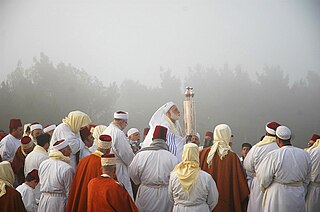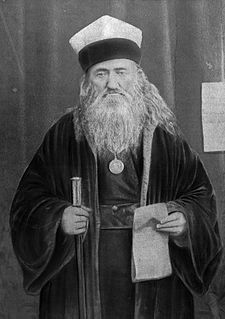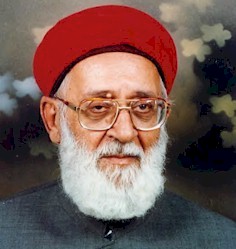
The Samaritans are an ethnoreligious group of the Levant originating from the Israelites of the Ancient Near East.

The Samaritan Pentateuch, also known as the Samaritan Torah, is a text of the first five books of the Hebrew Bible, written in the Samaritan alphabet and used as scripture by the Samaritans. It constitutes their entire biblical canon.

Eli was, according to the Books of Samuel, a High Priest of Shiloh. He delivers God's message to Hannah and Elkanah, a childless couple, that they will become parents of a son. The child, Samuel, is raised by Eli in the tabernacle, a tent-like structure which according to the Bible was used by the Israelites as a center for sacrifice to Yahweh. When Eli fails to rein in the abusive behavior of his sons, God promises to punish his family, resulting eventually in the death of Eli and his sons. Later biblical passages mention the fortunes of several of his descendants, and he figures prominently in Samaritan tradition.

Eleazar or Elazar was a priest in the Hebrew Bible, the second Kohen Gadol, succeeding his father Aaron after he died. He was a nephew of Moses.
Samaritan Hebrew is a reading tradition used liturgically by the Samaritans for reading the Ancient Hebrew language of the Samaritan Pentateuch, in contrast to Biblical Hebrew.

Mount Gerizim is one of the two mountains in the immediate vicinity of the West Bank city of Nablus, and forms the southern side of the valley in which Nablus is situated, the northern side being formed by Mount Ebal. The mountain is one of the highest peaks in the West Bank and rises to 881 m (2,890 ft) above sea level, 70 m (230 ft) lower than Mount Ebal. In Samaritan tradition, Mount Gerizim is held to be the highest, oldest and most central mountain in the world. The mountain is particularly steep on the northern side, is sparsely covered at the top with shrubbery, and lower down there is a spring with a high yield of fresh water.

John Hyrcanus was a Hasmonean (Maccabeean) leader and Jewish high priest of the 2nd century BCE. In rabbinic literature he is often referred to as Yoḥanan Cohen Gadol, "John the High Priest".

Jacob's Well is a deep well hewn of solid rock that has been associated in religious tradition with Jacob for roughly two millennia. It is situated a short distance from the archaeological site of Tell Balata, which is thought to be the site of biblical Shechem.

Abraham (Avraham) ben Samuel Firkovich (1786–1874) was a famous Karaite writer and archeologist, collector of ancient manuscripts, and a Karaite Hakham. He was born in Lutsk, Volhynia, then lived in Lithuania, and finally settled in Çufut Qale, Crimea. Gabriel Firkovich of Troki was his son-in-law.
In the Torah, Ithamar was the fourth son of Aaron the High Priest. Following the construction of the Tabernacle, he was responsible for recording an inventory to ensure that the constructed Tabernacle and its contents conformed to the vision given by God to Moses on Mount Sinai.

Saloum Cohen, also known as Shalom ben Amram ben Yitzhaq,, served as the Samaritan High Priest from 2001 until his death. He lived in Nablus in the West Bank and is buried in the cemetery of Kiryat Luza on Mount Gerizim.

Elazar ben Tsedaka ben Yitzhaq was the Samaritan High Priest from 2004 until his death. He was born in Nablus. He succeeded his cousin Saloum Cohen in 2004. According to tradition he is the 131st holder of this post since Aaron.
Yoseph ben Ab-Hisda ben Yaacov ben Aaharon;, served as the Samaritan High Priest from January 26, 1987 until his death. Prior to inheriting the post of high priest, he worked as a religious teacher and was principal of the Samaritan school. A noted author and scribe like many of his kinsmen, his houses in Nablus and on Mount Gerizim were open to visitors from all over the world who sought to understand the Samaritan teachings. As high priest, he sought to follow a policy of non-active involvement—maintaining peaceful relations as far as possible with all factions in the political conflicts of the region. He lived in Nablus in the West Bank and is buried in the cemetery of Kiryat Luza on Mount Gerizim. His brothers Aaharon and Yephet survived him, as did his wife, his four children, and seven grandchildren. Both Palestinian and Israeli dignitaries were present at his funeral. He was succeeded as high priest by his second cousin Levi ben Abisha ben Phinhas ben Yitzhaq.

Al-Khadra Mosque also known as Hizn Sidna Yaq'ub Mosque is a mosque situated on the lower slopes of Mount Gerizim in the southwestern quarter of the Old City of Nablus in the West Bank. The mosque is rectangular in shape, and its minaret rises 30 meters (98 ft).
Aharon ben Ab-Chisda ben Yaacob, also transliterated Aaron b. Abhisda b. Jacob, was the Samaritan High Priest. He had inherited the office upon the death of Elazar ben Tsedaka ben Yitzhaq as the eldest priest of the family of priests.
Aabed-El ben Asher ben Matzliach is the current Samaritan High Priest. He assumed office in 2013.
The Tolidah or Tulida is the oldest Samaritan historical work. It is written mainly in Hebrew, with sections in hybrid Samaritan Hebrew and Aramaic. It reached its final form in a manuscript copied by Jacob ben Harun in 1859 AD (1276 AH) with a parallel Arabic translation. Its full title is Ha-Tolidah ׳asher mit׳akeh beyn ha-Shemarim, which translates to "The Book of Genealogies that has been Transcribed by the Samaritans". Owing to its first publisher, it is sometimes known as the Chronicle Neubauer.












